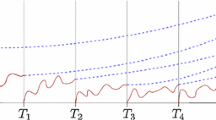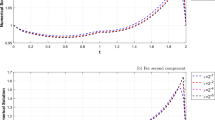Abstract
We present an explicit Runge-Kutta scheme devised for the numerical solution ofdelay differential equations (DDEs) where a delayed argument lies in the current Runge-Kutta interval. This can occur when the lag is small relative to the stepsize, and the more obvious extensions of the explicit Runge-Kutta method produce implicit equations. It transpires that the scheme is suitable forparallel implementation for solving both ODEs and more general DDEs. We associate our method with a Runge-Kutta tableau, from which the order of the method can be determined. Stability will affect the usefulness of the scheme and we derive the stability equations of the scheme when applied to the constant-coefficient test DDEu′(t)=λu(t) +μu(t −τ), where the lagτ and the Runge-Kutta stepsizeH n ≡H are both constant. (The caseμ=0 is treated separately.) In the case thatμ ≠ 0, we consider the two distinct possibilities: (i)τ ≥H and (ii)τ<H.
Similar content being viewed by others
References
C.T.H. Baker and C.A.H. Paul, A global convergence theorem for a class of PCRK methods and vanishing lag DDEs, Technical Report No. 229, University of Manchester (1993).
A. Bellen and M. Zennaro, Numerical solution of delay differential equations by uniform corrections to an implicit Runge-Kutta method, Numer. Math. 47(1985)301–316.
J.C. Butcher,The Numerical Analysis of Ordinary Differential Equations (Wiley, Chichester, UK, 1987).
J.R. Dormand and P.J. Prince, A family of embedded Runge-Kutta formulae, J. Comp. Appl. Math. 6(1980)19–26.
L.E. El'sgol'ts and S.B. Norkin,Introduction to the Theory and Application of Differential Equations with Deviating Arguments (Academic Press, New York, 1973).
A. Feldstein and K.W. Neves, High order methods for state-dependent delay differential equations with nonsmooth solutions, SIAM J. Numer. Anal. 21(1984)844–863.
E. Hairer, S.P. Nørsett and G. Wanner,Solving Ordinary Differential Equations 1, Springer Series in Computational Mathematics 8 (1980).
K.J. in 't Hout and M.N. Spijker, Stability analysis of numerical methods for delayed differential equations, Numer. Math. 59(1991)807–814.
P.J. van der Houwen and B.P. Sommeijer, Parallel iteration of high-order Runge-Kutta methods with stepsize control, J. Comp. Appl. Math. 29(1990)111–127.
A. Iserles and S.P. Nørsett, On the theory of Parallel Runge-Kutta methods, IMA J. Numer. Anal. 10(1990)463–488.
K.R. Jackson and S.P. Nørsett, The potential for parallelism in Runge-Kutta methods. Part 1: RK formulas in standard form, Technical Report No. 239/90, Computer Science Department, University of Toronto (1990).
K.R. Jackson, A survey of parallel numerical methods for initial value problems for ordinary differential equations, IEEE Trans. Magnetics 27(1991)3792–3797.
K.W. Neves, Numerical solution of functional differential equations with state-dependent lags, Doctoral Dissertation, Arizona State University (1973). (Ref. Univ. Microfilms 74 - 07101).
K.W. Neves and A. Feldstein, Characterization of jump discontinuities for state-dependent delay differential equations, J. Math. Anal. Appl. 56(1976)689–707.
B. Owren and M. Zennaro, Derivation of efficient continuous explicit Runge-Kutta methods, Technical Report No. 240/90, Department of Computer Science, University of Toronto (1990).
B. Owren and M. Zennaro, Order barriers for continuous explicit Runge-Kutta methods, J. Math. Comp. 56(1991)645–661.
C.A.H. Paul and C.T.H. Baker, Stability boundaries revisited — RK methods for delay equations, Technical Report No. 205, University of Manchester (1991).
C.A.H. Paul and C.T.H. Baker, Explicit Runge-Kutta methods for the numerical solution of singular delay differential equations, Technical Report No. 212, University of Manchester (1992).
C.A.H. Paul, A fast, efficient, very low storage, adaptive quadrature scheme, Technical Report No. 213, University of Manchester (1992).
L.F. Shampine, Some practical Runge-Kutta formulas, J. Math. Comp. 46(1986)135–150.
L. Tavernini, One-step methods for the numerical solution of Volterra functional differential equations, SIAM J. Num. Anal. 8(1971)786–795.
D.R. Willé and C.T.H. Baker, The tracking of derivative discontinuities in systems of delay differential equations, Technical Report No. 185, University of Manchester (1990).
M. Zennaro, Natural continuous extensions of Runge-Kutta methods, J. Math. Comp. 46(1986)119–133.
M. Zennaro,P-stability properties of Runge-Kutta methods for delay differential equations, Numer. Math. 49(1986)305–318.
Author information
Authors and Affiliations
Additional information
In memory of Professor Leslie Fox, Balliol College, Oxford
Work performed in part at The University of Auckland, New Zealand.
This paper is presented as an outcome of the LMS Durham Symposium convened by Professor C.T.H. Baker on 4th–14th July 1992 with support from the SERC under Grant reference number GR/H03964.
Rights and permissions
About this article
Cite this article
Baker, C.T.H., Paul, C.A.H. Parallel continuous Runge-Kutta methods and vanishing lag delay differential equations. Adv Comput Math 1, 367–394 (1993). https://doi.org/10.1007/BF02072017
Received:
Revised:
Issue Date:
DOI: https://doi.org/10.1007/BF02072017
Keywords
- Delay differential equation
- parallel continuous explicit Runge-Kutta methods
- vanishing lag
- iterated continuous extensions




